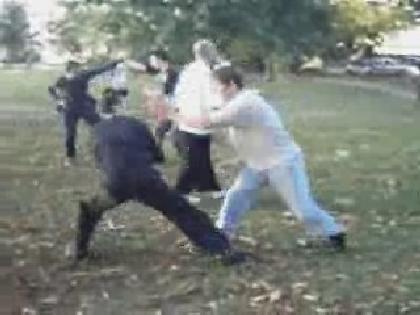QUESTIONS ON BREATHING METHODS AND CONTROL

Shaolin Wahnam students, regardless of whether they are in Shaolinquan or Taijiquan, can spar for an hour or two without feeling tired or out of breath because they practice breathing methods and control.
Questions on Breathing Methods and Control
The thread Breathing Methods and Control on the forum has been enormously useful for me. But there is something I do not quite understand. If I am practicing my Taijiquan very slowly, would it be possible for one breath to last me for a whole pattern, like “Move, Intercept and Punch”?
Zhang Wuji
Sifu's Comments
I suppose by now you would have the answer from your own experience.
This is an example of an academic question, i.e. the question comes from intellectualization. If you have direct experience, you would not ask it because you would have known the answer from your experience.
As mentioned earlier, this does not mean academic questions are not useful. They often help us to crystallize our thoughts on our experience, resulting in formulating the philosophy in question.
From direct experience you would have discovered that when your breathing is deep, you can have one breath to last for a whole pattern even when it is performed slowly. You can also have one breath for many patterns.
On the other hand, in certain situations a pattern may require more than one breath. If a long pattern is performed slowly and the practitioner is untrained in breath control, he may need more than one breath to perform it. Even when a pattern is short and is performed fast, if he is already out of breath he would need more breaths to perform the pattern. In this case he will be panting for air.
Wong Kiew Kit

Grandmaster Wong used a Taijiquan technique to brush away Chee Yong's attack
Also, the classics say to focus on the “yi”, not the “qi” (All of the “shen” is on the “yi”, not the “qi”. If on the “qi”, you will stagnate). May I ask Sifu what this means? Does “qi” here refer to breathing, or to the vital energy of the body? If the latter, should we not be mindful of it so we can direct it?
Zhang Wuji
Sifu's Comments
This summarizes the essence of Jeffrey's points when he said in the thread on “Breathing Methods and Control” that having consciously learnt the techniques of breath control, one then breathes spontaneously when he spars or perform a set in solo. Although he may not consciously direct his breathing, his breathing is well synchronized with his physical movements. How is this possible? It is due to “yi” or intention.
Using Jeffrey's examples, suppose a student learns the following three patterns in a combat sequence:
- Green Dragon Shoots Pearl
- White Snake Shoots Venom
- Cross Hands-Thrust Kick
Now suppose he is attacked on a street, and he uses these same three patterns to defeat the assailant. His response will be fast and spontaneous, without thinking of the breathing structure that he had earlier learnt to match the sequence. He just focuses on his intention of subduing the attacker. This is “focusing on yi and not qi”.
After having successfully dealt with the assailant, the student looks back at what he has done. He discovers that he did not use the breathing structure “in-out-in-out-out-swallow” as he was taught, but instead used “follow-explode-swallow” spontaneously. He could do so because of his systematic training. Had he focused on his breathing structure while fighting, his response would not have been smooth. This is “if on qi, it will stagnate”.
Your question of whether qi refers to breathing or energy, and if it is the latter, should we not be mindful of it to direct it, is another example of an academic issue.
Nevertheless, for intellectual pleasure, here is the answer. Qi here refers to the vital energy in the breathing, and not the vital energy in the body. (It is possible to use the vital energy already in the body for combat, instead of using the vital energy in the breathing, such as by purposely closing the mouth. But this will be very unwise.)
In this case we should not be mindful of qi as we are not actively directing it. If we were to be mindful of qi to direct it during combat, it would make the physical movements stagnate, thus reducing combat efficiency. We should be mindful of what we want to do, i.e. mindful of yi or intent. In this case, the intent is to apply the three patterns effectively to defeat the opponent.
Yi directs qi, which in turn directs the physical movements. In other words, as you intent to strike your opponent, your qi flows accordingly and your execution of your techniques is fast and powerful, but without muscular tension. This is possible only through systematic training. During training (but not during combat), you may be mindful of qi to direct it. Here your physical movements are usually slow, like when you practice your Taijiquan forms.
But when you have developed the necessary skills, you use yi to direct qi, which can result in your physical movements to be very fast, as in combat. You had some experience of this process at the Sabah Intensive Chi Kung Course when you exploded force or fajing.
Wong Kiew Kit
- The Evolution of Taijiquan from Shaolinquan
- General Practice and Training, and Sparring Methodology
- Combat Philosophy on Retreat and Yielding
- Difference in Stances
- The Use of Internal Force
- Fa-jing and Qin-na
- Academic Questions and Direct Experiences
- Yin-Yang, God and Health
- Spirituality and Over-Training
- Questions on Sinew Metamorphosis
- Questions on Breathing Methods and Control
- Taoist Philosophy and Concept of Open and Close
LINKS
